| C H A P T E R 1 |
|
Cluster Platform 15K/9960 System Introduction |
This chapter contains descriptions of the hardware, software, and documentation for the Cluster Platform 15K/9960 system.
The Cluster Platform 15K/9960 system is a platform with shared storage that supports highly available applications. You can use this two-node cluster system for a variety of production services, such as a file server, a Web server, a mail server, or an Oracle database server.
The system is made up of two Sun Fire 15K domains that act as two cluster nodes running independent instances of the Solaris operating environment. A set of four Sun StorEdge S1 storage devices act as mirrored boot disks for the cluster nodes. A terminal concentrator provides console access to the management server and the Sun Fire 15K system controllers.
operating environment. A set of four Sun StorEdge S1 storage devices act as mirrored boot disks for the cluster nodes. A terminal concentrator provides console access to the management server and the Sun Fire 15K system controllers.
An administration network hub provides access from the management server to the cluster nodes and to the system controllers. Private interconnects provide high-bandwidth access between the cluster nodes. A single Sun StorEdge 9960 storage system provides highly redundant and available data storage for both of the cluster nodes.
The Cluster Platform 15K/9960 system uses Sun Cluster 3.0 software to provide global file systems, global devices, and scalable services. These features enable the cluster nodes to run distributed applications, while providing client access through a single IP address.
3.0 software to provide global file systems, global devices, and scalable services. These features enable the cluster nodes to run distributed applications, while providing client access through a single IP address.
This section contains general descriptions of the components of the Cluster Platform 15K/9960 system, including the nodes (servers) and the network.
The system includes two Sun Fire 15K servers. Each server is configured with a single domain that acts as the cluster node. Minimally, the servers contain the following components:
For a fully redundant Cluster Platform 15K/9960 system, the maximum number of system boards is 18, and the maximum number of CPUs is 100. The maximum number of hot-swap PCI slots is 72 (36 66-MHz and 36 33-MHz).
The management server is the repository for the operating environment, software, and patches. The management server provides access to the cluster console and functions as a JumpStart server (installation server) for the cluster nodes.
server (installation server) for the cluster nodes.
The management server contains the following components:
 T1 AC200 system
T1 AC200 system
 IIe CPU
IIe CPU
The Cluster Platform 15K/9960 system includes one Sun StorEdge 9960 system that provides shared storage for the cluster nodes. The array is connected to the cluster nodes by a minimum of two FC-AL host adapters per domain.
The Sun StorEdge 9960 system contains the following components:
You can configure the shared storage by using the Solstice DiskSuite software or the VERITAS VxVM software.
software or the VERITAS VxVM software.
The 8-port terminal concentrator provides serial access to the management server and cluster node consoles. The terminal concentrator is accessible only over 10BASE-T Ethernet.
The boot devices are mounted in the expansion cabinet and are connected to the two cluster nodes. The devices are Sun StorEdge S1 drives with 18-Gbytes of storage capacity.
The administrative hub is a 3com, 12-port, 10/100BASE-T Ethernet hub that is preinstalled in the Sun StorEdge expansion cabinet.
The private interconnects connect the cluster nodes. The interconnects use Sun Gigabit Ethernet adapters (ge0 and ge1) on two separate Hot Swap PCI assemblies on separate expanders to avoid a controller or expander single-point-of-failure. FIGURE 1-1 shows the layout of the private interconnect.
FIGURE 1-1 Private Interconnect
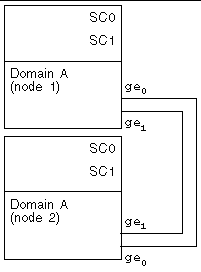
The public network uses a Sun Quad FastEthernet interface (qfe0) on both cluster nodes. The qfe4 interface on both cluster nodes is reserved to be the network adapter failover (NAFO) interface for qfe0.
interface (qfe0) on both cluster nodes. The qfe4 interface on both cluster nodes is reserved to be the network adapter failover (NAFO) interface for qfe0.
FIGURE 1-2 shows the layout of the public network.
|
Note - In the following diagram, the public network hub can be a hub or a switch. |

The Cluster Platform 15K/9960 system can have two administration networks. The internal administration network uses the administration hub that is supplied with the system. The external administration network needs a customer supplied network hub.
The internal administration network helps improve security by isolating the administration and JumpStart server traffic on the Sun Fire 15K system controllers. The administration network hub provides connections to the management server over the eri1 interface, to the cluster nodes, and to the main (active) and spare (standby) system controllers. FIGURE 1-3 shows the layout of the internal administration network.
|
Note - In the following diagram, the administration network hub can be a hub or a switch. |
FIGURE 1-3 Internal Administration Network
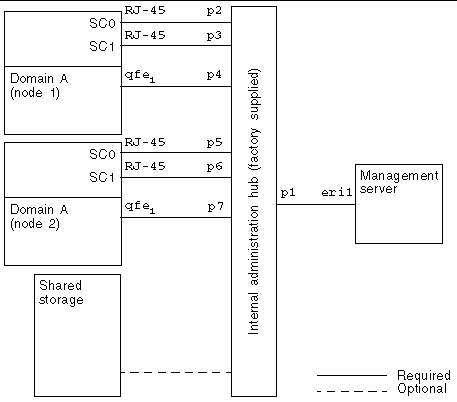
The external administration network helps improve security by isolating the network traffic to the management server over the eri0 interface and to the terminal concentrator. FIGURE 1-4 shows the layout of the external administration network.
|
Note - In the following diagram, the external network hub can be a hub or a switch. |
FIGURE 1-4 External Administration Network
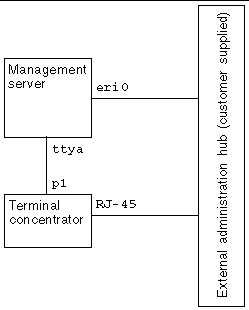
The system includes one 72-inch Sun StorEdge expansion cabinet that contains two power sequencers, one front door option, one rear door, and one fan assembly.
If the cluster environment requires hardware in addition to the provided components, such hardware must be installed and configured only after the management server configuration has taken place and the cluster nodes have been booted into a cluster environment.
|
Note - Only after the cluster environment has been established can additional hardware be installed. |
The Cluster Platform 15K/9960 system includes the following software components that run on the management server:
The Cluster Platform 15K/9960 system includes the following software components that run on the nodes:
A collection of software patches are automatically applied to each cluster node during the recovery. The patches are located in the /jumpstart/Patches directory on the management server.
The Sun Management Center software is included with the Cluster Platform 15K/9960 system. You can use this software to monitor and manage the system. The Sun Management Center software uses Java software and simple network management protocol (SNMP) to provide enterprise-wide management of Sun products.
software and simple network management protocol (SNMP) to provide enterprise-wide management of Sun products.
You can use the Sun Management Center software to monitor and manage the entire system, the subsystems, the components, and the peripheral devices. You can also extend and enhance the management capability of the hardware and software. For instance, you can add or remove system boards to or from the Sun Fire 15K servers.
TABLE 1-1 contains descriptions of the features you can use with the Cluster Platform 15K/9960 system:
Sun Management Center software consists of three component layers: the console layer, the server layer, and the agent layer. The software architecture is based on the manager-agent architecture. The three layers provide the following services:
FIGURE 1-5 contains a logical view of the three architecture layers:
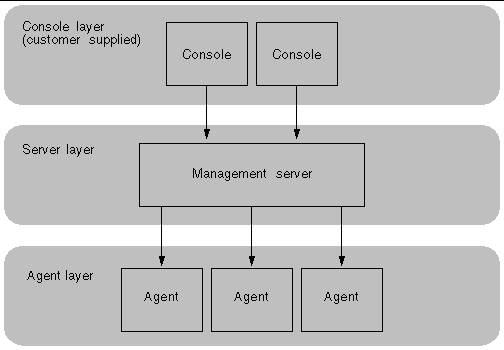
The Sun Management Center software is installed and set up automatically as part of the Cluster Platform 15K/9960 system installation. No user interaction is required during this process. The advanced and premier Sun Management Center software options are included in the installation. These additional options require the appropriate licenses.
The resulting configuration is depicted in FIGURE 1-6, which shows where the Sun Management Center Server, Console and Agent components are installed.
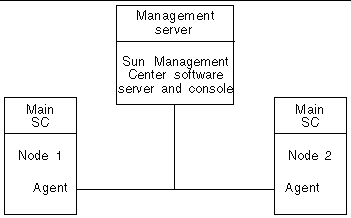
You can install a Sun Management Center software agent on each of the Sun
Fire 15K system controllers (SCs). You can find instructions on installing the agent in the Sun Management Center 3.0 Supplement for Sun Fire 15K Systems.
The Sun Management Center software image is located on the management server in the /jumpstart/Packages/SunMC3.0/Update3 directory. This directory has been shared and can be accessed through NFS from the system controllers. Use the following path to locate the software:
/net/management_server_hostname_or_IPaddress/jumpstart/\
Packages/SunMC3.0/Update3
The VERITAS VxVM 3.1.1 software is included on the management server in the /jumpstart/Packages/VM3.1.1 directory. You can use VxVM to configure the shared storage after the management server is configured and the cluster nodes are booted into a cluster environment. A software license is not provided for the installation. You must purchase the license separately before you install the software.
Synchronized time is an important requirement for a data center. All aspects of managing, securing, planning, or debugging a network involve determining when events happen. Time is the critical element that allows an event on one network node to be mapped to a corresponding event on another. Time synchronization is especially critical on cluster nodes.
The Cluster Platform 15K/9960 System provides automatic set up of the network time protocol (NTP) service to synchronize the time on both cluster nodes. The management server provides NTP service for both nodes. The management server can either synchronize to its own local clock or to other NTP servers.
Synchronizing to the local clock on the management server is inadvisable because the local clock may wander from the wall-clock time of the rest of the data center. Ideally, the entire data center should be synchronized to universal coordinated time--the international time standard. The system controllers on the cluster nodes are not synchronized to the management server because the SCs cannot synchronize to an external source. FIGURE 1-7 shows the NTP architecture for the Cluster Platform 15K/9960 cluster.
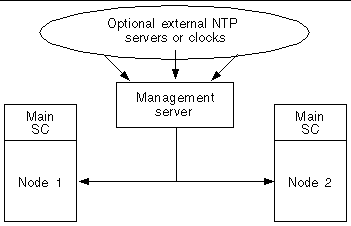
For instructions on how to set up the NTP service, see Section , Setting Up the NTP Server on the Management Server.
The management server splash page is automatically configured on the management server during the initial configuration of the Cluster Platform 15K/9960 system. This Web-based administration interface enables you to access documentation and other features of the Cluster Platform 15K/9960 system.
If the management server is reachable from an outside network, the splash page can be accessed by entering the server name in the URL location text box of a browser running on your workstation or PC, as in the following example:
http://management_server_name/ |
You can access the following tools and Web-based software on the management server by using the splash page interface:
 Manager, a cluster configuration GUI
Manager, a cluster configuration GUI
You can access the following documentation from the management server splash page:
The management server splash page also contains links to the following topics:
The Cluster Platform 15K/9960 system is shipped with printed and online documentation. The documentation includes printed manuals on the Cluster Platform 15K/9960 system, the individual hardware components, and the Solaris operating environment. The online documentation includes manuals on the hardware components and the software components that contribute to the Cluster Platform 15K/9960 integrated product.
You can access the online documentation by using the management server splash page, the AnswerBook2 environment, or the Acrobat Reader if a PDF version of the document exists.
The management server is preconfigured as an AnswerBook2 software server. You can access the AnswerBook2 collections by using your Web browser. The management server must be accessible to the client. If the management server is operating on a secure network, some additional configuration may be needed.
Use the following URL to access the AnswerBook2 server:
http://management_server_name:8888/ |
The following AnswerBook2 collections are included with the Cluster Platform 15K/9960 system:
Answerbook2 software is installed in the /opt/answerbooks directory and can be further customized by the server administrator.
You can view PDF files on the management server by using the Acrobat Reader 4.0 software, installed in the /opt/Acrobat4 directory.
Copyright © 2002, Sun Microsystems, Inc. All rights reserved.